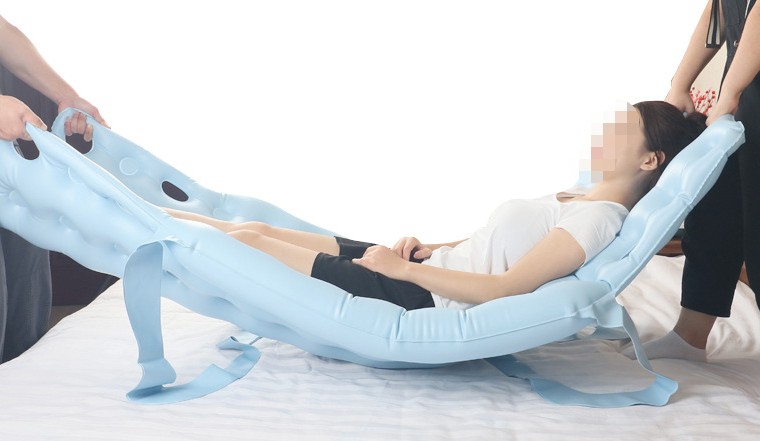Selecting the appropriate medical air cushion set is a pivotal decision that directly impacts a patient’s comfort, well-being, and critically, the prevention and healing of pressure ulcers. With a variety of advanced systems available, navigating the options can seem daunting. This guide will walk you through the key considerations to ensure you make an informed choice that best suits the patient’s specific needs and the care environment.
1. Why the Right Choice Matters
An ill-suited medical air cushion can be ineffective, uncomfortable, and even exacerbate existing conditions. Choosing correctly means providing optimal pressure redistribution, managing moisture, and offering a supportive surface that promotes healing and restful sleep. A wise investment in the right system can prevent costly complications, reduce caregiver strain, and significantly improve a patient’s quality of life.
2. Key Factors to Consider When Choosing a Medical Air Cushion Set
2.1. Patient Needs and Risk Level
This is arguably the most crucial starting point. Different patients have different requirements based on their mobility, skin integrity, and medical condition.
- Pressure Ulcer Risk Assessment: Tools like the Braden Scale or Norton Scale are used by healthcare professionals to determine a patient’s risk level (low, moderate, high, very high) for developing pressure ulcers. Patients at higher risk will require more sophisticated air cushion systems.
- Presence of Existing Pressure Ulcers: If a patient already has pressure ulcers, the type and stage of the wound will dictate the required level of pressure relief and microclimate management. Therapeutic cushions are specifically designed for this purpose.
- Mobility Level: Is the patient completely immobile, can they slightly reposition themselves, or do they have limited mobility? The less mobile a patient is, the greater the need for active pressure redistribution.
- Patient Weight and Size: Ensure the air cushion set has an adequate weight capacity. Bariatric patients require specialized bariatric air cushion systems designed to support heavier weights and broader body frames while still providing effective pressure relief. Dimensions of the bed frame should also be considered.
- Duration of Immobility: For short-term needs (e.g., post-surgery recovery), a simpler system might suffice. For long-term care or chronic conditions, a more durable and advanced system is advisable.
2.2. Type of Air Cushion System
Medical air cushions primarily fall into a few categories based on their mechanism:
- Alternating Pressure Systems: These systems consist of multiple individual air cells that alternately inflate and deflate in a programmed cycle. This continuous change in pressure points ensures that no single area of the body is subjected to prolonged pressure, promoting blood flow and preventing tissue breakdown. They are excellent for both pressure ulcer prevention and treatment.
- Low Air Loss Systems: These cushions feature a continuous, gentle flow of air through microscopic holes on the mattress surface. This airflow helps to wick away moisture (perspiration) and regulate temperature, creating a dry and cool microclimate around the patient’s skin. This is vital for skin integrity, as moisture can lead to skin maceration and increase vulnerability to pressure ulcers.
- Combined (Hybrid) Systems: Many advanced air cushion sets offer a combination of both alternating pressure and low air loss features, providing comprehensive pressure redistribution and microclimate control. These are often ideal for patients at very high risk or with existing complex pressure ulcers.
- Static Air Cushions: While more common for wheelchair or seat cushions, some bed overlays use static air chambers that conform to the body’s shape. These offer basic pressure relief but lack the dynamic capabilities of alternating pressure systems.
2.3. Features of the Pump/Control Unit
The pump is the “brain” of the air cushion system and its features greatly impact usability and effectiveness:
- Noise Level: A quiet pump is essential for patient comfort and sleep quality, especially in home care settings. Look for models explicitly advertised as “ultra-quiet” or “low noise.”
- Cycle Time Adjustability: The ability to adjust the inflation/deflation cycle time allows caregivers to fine-tune the pressure changes according to patient comfort and clinical needs.
- Pressure Adjustment Settings: Look for options to adjust the firmness or pressure levels of the air cells, allowing for customization based on patient weight and comfort. Digital controls often offer more precise adjustments.
- Alarm Features: Important safety features include alarms for low pressure, power failure, or system malfunctions, alerting caregivers to potential issues.
- Ease of Use: Intuitive controls and clear displays make it easier for caregivers to operate and monitor the system correctly.
2.4. Mattress/Overlay Construction and Materials
The physical construction of the mattress or overlay also plays a significant role:
- Cell Design: Look at the size and arrangement of the air cells (e.g., individual cells, horizontal or vertical orientation). Some designs offer better “envelopment” (how well the body sinks into the surface) and “immersion” (how evenly the weight is distributed).
- Base Layer: A non-inflatable foam base layer or “cell-in-cell” design provides a safety bottom-out prevention layer in case of power failure or air loss.
- Cover Material: The mattress cover should be breathable, waterproof, vapor permeable, and easy to clean. Anti-shear properties are also beneficial to reduce friction that can contribute to skin breakdown. Consider materials that are anti-microbial for infection control.
- Durability: High-quality materials (e.g., medical-grade PVC, TPU-coated nylon) and robust construction are key for longevity, especially for continuous use.
2.5. Ease of Cleaning and Maintenance
Infection control is paramount. Choose a system with a removable, washable, and easily disinfectable cover. Minimal crevices in the mattress design facilitate thorough cleaning.
2.6. Budget and Warranty
While an important consideration, prioritize patient safety and effectiveness over cost alone. A quality medical air cushion is an investment. Check the warranty for both the pump and the mattress, as this indicates manufacturer confidence in the product’s durability.
3. Consulting a Professional
Given the complexities and critical nature of pressure injury prevention and treatment, it is highly recommended to consult with a healthcare professional (e.g., a doctor, wound care nurse, or occupational therapist) before making a purchase. They can assess the patient’s specific needs, risk factors, and recommend the most suitable type and model of medical air cushion set.
4. Conclusion
Choosing the right medical air cushion set is a nuanced decision that demands careful consideration of various factors. By focusing on the patient’s specific needs, understanding the different types of systems and their features, and considering practical aspects like maintenance and budget, you can select a system that provides optimal comfort, effective pressure relief, and contributes significantly to healing and overall well-being. This informed choice is a crucial step towards providing the best possible care.

